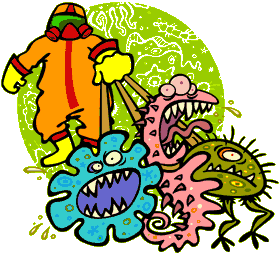
Viva la Virus! The rest of the animal kingdom may have seemingly changed their spots -- chimps, it turns out, are murderous warriors, dolphins are flipped-out cannibals, and even man's best friend apparently has his own selfish canine agenda, according to the latest research. But consider the true-blue virus. The folks at the distinguished Centers For Disease Control and Prevention do -- and then some.
The Abdominal Strain
Take the recent case of the smallpox virus. In a MONDO 2000 interview, Richard Preston, author of The Cobra Event and The Hot Zone, describes the symptoms of this disease:
"People think that smallpox is a bad case of chickenpox. Whew -- it isn't anything like that. In some ways it's uglier than Ebola! In classic smallpox, it burns the skin off your body, leaving pus all over. And then there's something called the black pox or flat smallpox, in which the body is covered with flat black marks, and pustules erupt all over the surface of the gut, and the stomach blows up three, four times. You get blood blisters extending through the entire GI tract. The gut lining separates because of bleeding behind it. It comes off, and the rectum actually turns inside out and hangs outside the body. Then everything hemorrhages and you die."
The CDC has long been holding on to the last confirmed batches of smallpox. This summer, the World Health Organization faced a ticklish decision -- whether to move one of the world's deadliest killers off death row and into the extermination chamber. This time, smallpox got the governor's call. Consequently, the very people charged with helping exterminate the disease are now, in effect, charged with preserving it. Not surprisingly, it takes a special breed of scientist to summon enthusiasm for such a task.
"We're the Library of Congress for pathogens!" says Dr. C.J. Peters, the chief of the CDC's special pathogens department. The CDC keeps watch over 5,000 different strains of viruses that are tucked cozily away in special tubes stored in liquid nitrogen. The strains originate from 30 main species of virus, including the ever-popular Ebola, hanta, and smallpox viruses.
That number sounds like nothing next to the nifty collection of bacteria in the CDC's Meningitis and Special Pathogens Department -- over 80,000 strains! Scientists experiment with the pathogens, trying to figure out things like mechanism of transmission, lifespan, and the conditions necessary for survival of the pathogen. But the media spotlight is on viruses, possibly because, while we have antibiotics for bacteria, there is no first-line defense against viruses.
Most of the work is done by 15 scientists in the BSL4 (Biosafety Level Four) Lab, located on highly residential Clifton Drive in Atlanta, next door to Emery University. The lab is kitted out specially for handling and storing the world's deadliest pathogens, and there's only one other laboratory like it in the USA (though Canada, Australia, France, and Russia each have one too). You'd think a community would be a little squeamish about a BSL4 lab in their midst, but, according to Peters, BSL4 labs are our "friends" -- it's been the labs with less vigilant standards that have produced all the disastrous mishaps.
Whoops Apocalypse
Mishaps, indeed! BSL4's were largely spawned by the horror that hit the University of Birmingham in England more than 20 years ago. Somehow, a sample of the smallpox virus got away from veteran research scientists and worked its way into the air duct system of the building, infecting medical photographer Janet Parker, who had a darkroom above the lab. Parker died a wretched death, and Henry Bedsen, the lead scientist of the lab, slashed his own throat out of guilt. The scientific community responded by coming up with new protocols and new labs that had an unprecedented level of containment. In fact, as CDC scientists like to point out, BSL4 labs are built to withstand the impact of a DC-9 airplane crashing into the building.
Peters plays down the intensity of his work: "Yes, we wear spacesuits, just like in the movies," he laughs, "but our labs are a lot less fancy and futuristic looking." Maybe so, but the procedures are pretty complex. Scientists have to shower down even before they suit up to enter the BSL4 lab, which is, of course, hermetically sealed. No phone calls or interruptions are allowed. The stress of working with viruses that can make your eyeballs bleed is so colossal that nobody is allowed to be in Level 4 for more than four hours at a time. Once outside, the researcher must shower off in the suit, then shower again without it, and all equipment that goes in or out is sterilized in each direction.
But in spite of the dangers, accidents are relatively rare. Peters says he knows of only one casualty at the CDC in the last 20 years, a janitor who was infected with Rocky Mountain Spotted Fever, a BSL3 pathogen. In most cases, people contract RMSF from a tick bite and, if untreated, develop fever, vomiting, and a rash on their hands and feet. Mortality rates as high as 30 percent were reported for RMSF in the pre-antibiotic era, compared to 4 percent currently, according to emedicine. Apparently, it's a lot higher for janitors who are just given it.
Apart from that one hiccup, the CDC is generally regarded by the world's scientific community -- and, increasingly, the world's anxious citizens -- as an institution unparalleled. CDC scientists are the people primarily responsible for such triumphs as the identification of the deadly hanta virus, and the containment of the Ebola virus in Africa. They tread where others fear to. As Peters says, "It takes a certain eccentricity, a kind of thrill-seeking scientist, one that thrives on adventure."
See also: Biohazard!
Heidi Kriz is a travel writer who has learned a thing or two about disease the hard way.
